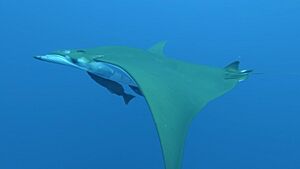Chilean devil ray facts for kids
Quick facts for kids Chilean devil ray |
|
|---|---|
 |
|
| Conservation status | |
| Scientific classification | |
| Genus: |
Mobula
|
| Species: |
tarapacana
|
The Chilean devil ray (Mobula tarapacana) is a fascinating type of ray. It's also known by other names like the box ray or sicklefin devil ray. These amazing creatures are found all over the world in warm ocean waters. You can often spot them swimming just below the surface.
Chilean devil rays usually live far out in the ocean. Sometimes, they come closer to the coast. They can grow quite large, with their disc (body) reaching up to 3.7 m (12 ft) wide!
Amazing Deep Dives
Scientists used to think Chilean devil rays only lived near the surface. But new discoveries show they are incredible deep-sea divers! These rays can dive to depths of up to 1,896 metres (6,220 ft). This makes them one of the deepest-diving ocean animals known.
How They Dive So Deep
When a Chilean devil ray dives, it often follows a special pattern. It dives very deep, then slowly works its way back up. It does this by "levelling up" for a short time, then moving higher. This pattern might help them find food. Sonar (sound waves) shows that rays often stop where there are lots of prey.
Rays have two main deep-dive patterns:
- Stepwise dives: These dives usually happen once every 24 hours. The ray goes to its deepest point and comes back up after 60 to 90 minutes.
- Longer dives: Less often, a ray might dive up to 1,000 meters and stay down for up to 11 hours! These longer dives might be for traveling, not just for finding food.
Staying Warm in Cold Water
Diving so deep means going into very cold water. Chilean devil rays have a special organ called the retia mirabilia. This organ is a network of blood vessels. It helps keep the ray's brain warm even in the freezing deep ocean.
Before and after a deep dive, rays spend at least an hour near the warmer surface water. This suggests they are warming up their bodies before diving. It also helps them recover from the cold after their deep journey.


